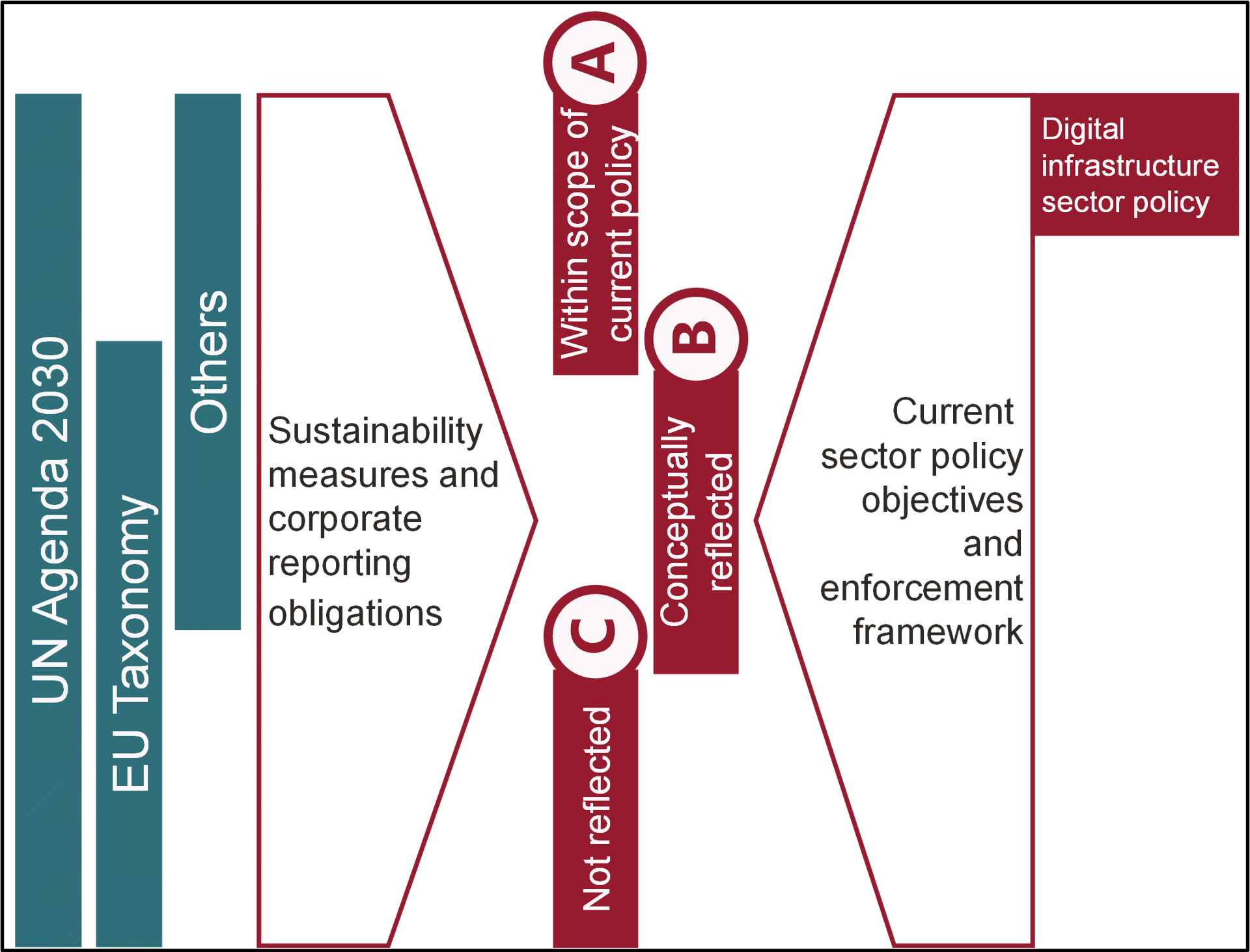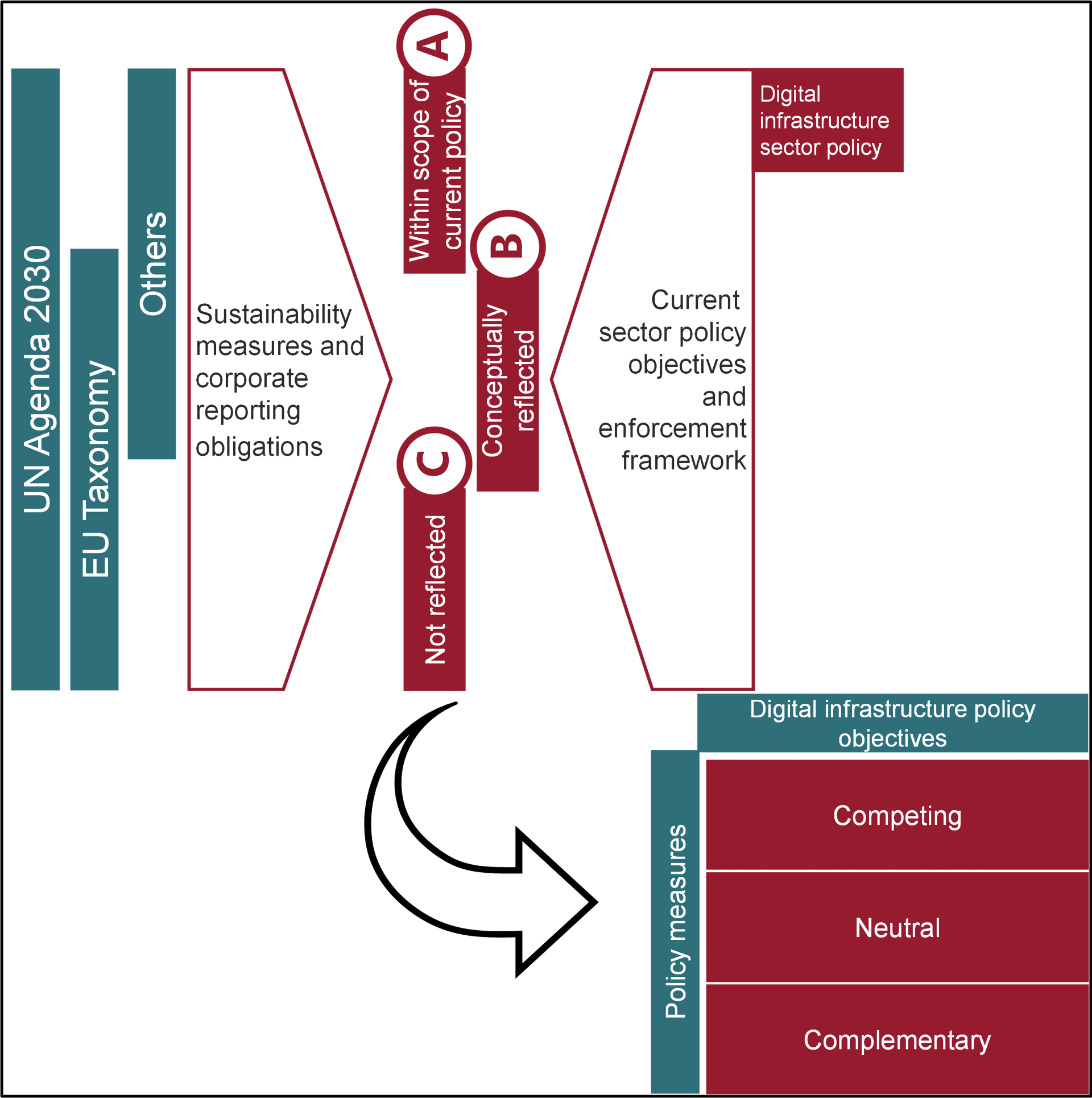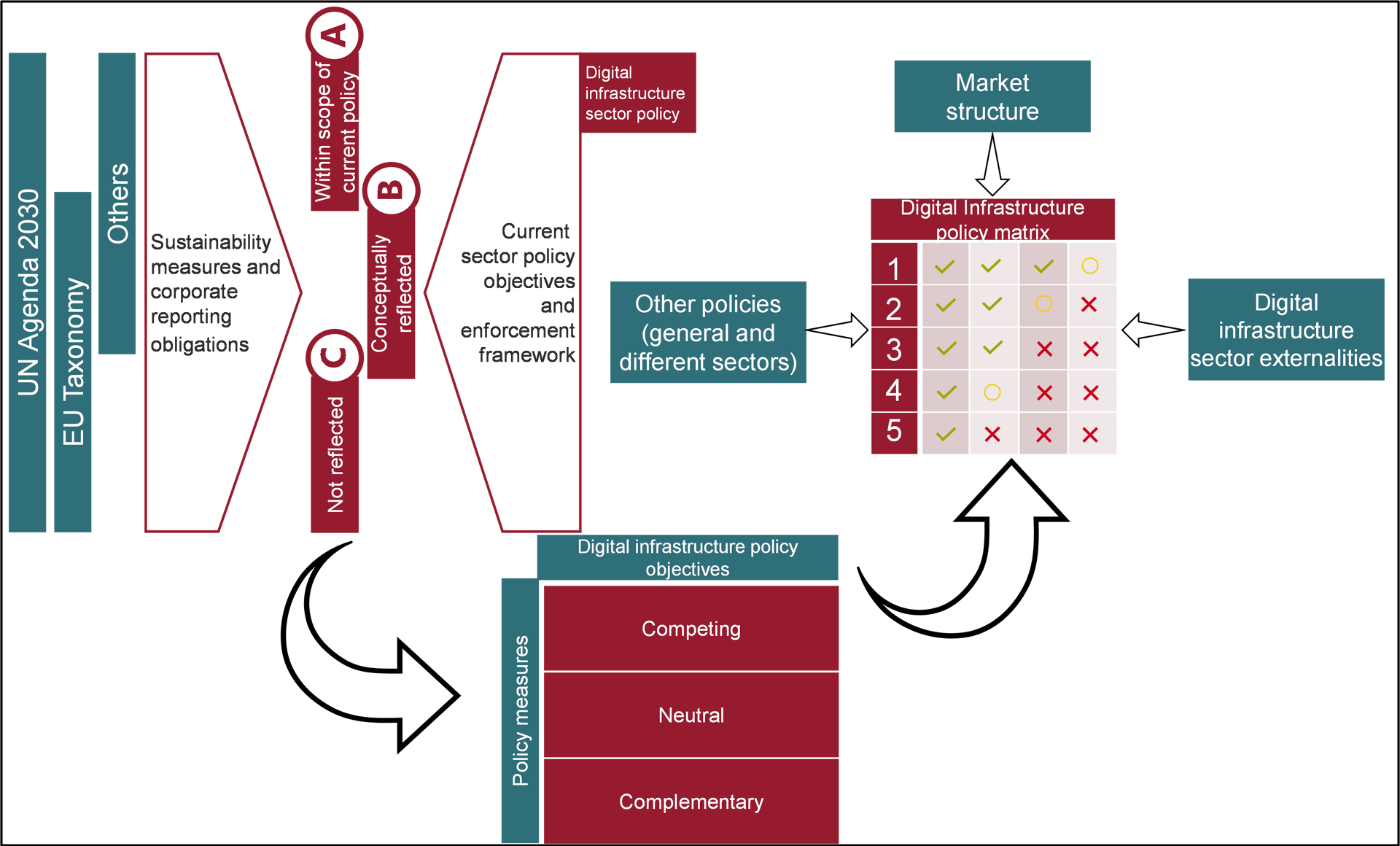The policy need to limit the environmental impact of economic activity affect all sectors, whether directly or indirectly.
Regulations for power generation, the consumption of goods and services, the circular economy and building standards all influence how companies and individuals act. For the digital infrastructure sector, including both telecommunications networks and infrastructure such as data centres, three key themes can be identifies:
- The sector itself contributes to resource consumption and exponentially increasing demand for digital services leads to increased consumption, partly offset by major advances in energy and resource efficiency.
- Digitalisation, enabled by digital infrastructure, is an important driver of sustainability. It helps the economy to become more efficient and migrate to more sustainable forms of production and consumption, e.g. by substituting travel by digital communications.
- The digital infrastructure itself is affected by climate change, where challenges can only grow: equipment will need more cooling as heatwaves become more common and extreme weather could lead to damage to infrastructure and more power outages. Given the importance of digital services to the economy, the industry thus needs to adapt so users can keep relying on it to provide resilient services.
New questions therefore arise for policymakers and regulators about how the industry is regulated and how new policy objectives related to sustainability will interact with existing ones. To begin to provide answers, policy makers need to consider three things: how to measure environmental sustainability; balancing improvements in sustainability against other sectoral policy goals; and assessing the wider economic impact of the sector. We look at each of these in turn.
How to measure sustainability
Any policy that aims to increase sustainability requires a framework to measure changes in sustainability. However, environmental sustainability covers many factors.
To guide the transition to a sustainable economic system, the United Nations enacted the 2030 Agenda for Sustainable Development in 2015. At its core are 17 Sustainable Development Goals defined by the UN. Implementing the agenda has become the legislative focus of the current European Commission (EC), whose five-year term ends in 2024. Numerous policies have been put forward to achieve a more sustainable economy based on the EU Taxonomy Regulation for "green" / "sustainable" economic activities. The taxonomy, a classification system developed as part of the EU Sustainable Finance Action Plan, covers six environmental objectives:
- Climate change mitigation
- Adaptation to climate change
- Sustainable use and management of water or marine resources
- Transition to a circular economy
- Pollution prevention or control
- Protection and restoration of biodiversity and ecosystems
The overarching purpose of the taxonomy is to give participants in the financial and real economy a framework for their sustainability reporting. The goal is to create transparency and comparability for investors, business partners and observers. Efforts to this end are still under way. So far the EC has defined the relevant criteria that companies must disclose for only two of the environmental goals - climate protection and adaptation to climate change; the rest will be agreed in the future.
Based on these or similar frameworks, policymakers and regulators need to consider how to measure the impact of the digital infrastructure sector on environmental sustainability goals. They then need, where necessary, to define quantitative and qualitative KPIs to underpin monitoring of progress towards those goals, any regulations that might be required and assess how these are reflected in the current sector policy and enforcement framework.
How to weigh environmental sustainability against other sectoral policy goals
Policymakers need to look at the sector’s current regulatory frameworks and what measures could be taken to influence the sector’s sustainability impact – and the impact of sustainability efforts on the sector. In particular they should examine whether regulatory powers already cover aspects of environmental sustainability (e.g. type approval for equipment which includes energy efficiency standards) or could be adapted to take environmental sustainability into account (e.g. setting price controls which incentivise reductions in energy consumption and take account of the resulting costs). Alternatively, they might conclude that new legal frameworks are required for the sector (e.g. specific regulatory powers to set environmental standards and targets).

Any new or revised policies with respect to sustainability cannot be set in isolation. The existing objectives of sector regulation, and how they might interact with steps to improve the sector’s environmental sustainability, must be borne in mind. They are likely to fall into three categories: competing, neutral and complementary goals. Three current policy goals set out in the EU Electronic Communications Code serve to illustrate possible interactions with sustainability aims:

“[P]romote competition in the provision of electronic communications networks and associated facilities, including efficient infrastructure-based competition, and in the provision of electronic communications services and associated service” is a goal that could be considered at odds with sustainability given that the efficient use of a monopoly network could have a lower environmental impact than several parallel competing networks.
“safeguarding the efficient use and ensuring the effective management of radio spectrum and of numbering resources” could be regarded as an objective that is unaffected by environmental sustainability goals and has no effect on those goals.
“promote connectivity and access to, and take-up of, very high capacity networks, including fixed, mobile and wireless networks, by all citizens and businesses of the Union” could be viewed as a policy that helps achieve greater digitalisation and thereby contributes to environmental sustainability, albeit with the roll out and operation of networks imposing some environmental cost.
How to measure the wider economic impact of sector-specific sustainability goals
Even if sector-specific environmental policy goals are carefully balanced, they cannot be viewed in isolation given the wider economic impact of the sector and its interlinkages. That being the case, it is important to take into account two further issues when considering the implementation of direct sector-specific measures:
- Are such measures competing, neutral or complementary to other policy frameworks, e.g. policies affecting the energy sector?
- Are they beneficial, neutral or detrimental to environmental sustainability in other economic sectors due to indirect impacts / positive externalities of the sector?
For example, measures that are beneficial for environmental sustainability within the sector-specific framework may lead to a reduction in economic activity in the sector and spill over to others, resulting in positive externalities for environmental sustainability not materialising. Take restrictions on mmWave frequencies as one hypothetical example. The use of such frequencies can lead to very dense deployment of mobile communications equipment and higher energy demand. Curbing the use of mmWave frequencies could reduce the sector’s energy consumption and thus CO2 emissions. But it would also impede new low-latency applications (IOT, autonomous driving) that have the potential to cut energy consumption in areas such as transport, industrial automation and building management that rely on the mobile technologies that use these frequencies.
As for steps designed to impact inputs to the sector, such as limits to electricity consumption, applying measures to the inputs at source (e.g. to influence how electricity is produced) may be more effective than applying them downstream in the digital infrastructure sector itself.

Conclusion
Setting environmental sustainability policies for the digital infrastructure sector will be a careful balancing act. This does not imply ruling out sustainability as an explicit future policy goal – after all, climate change will have an impact on telecommunications networks, just as it will on many parts of the economy. But it does mean that any measures taken to attain environmental goals need to be carefully considered in light of sector externalities and the effectiveness of sector-specific policies.





